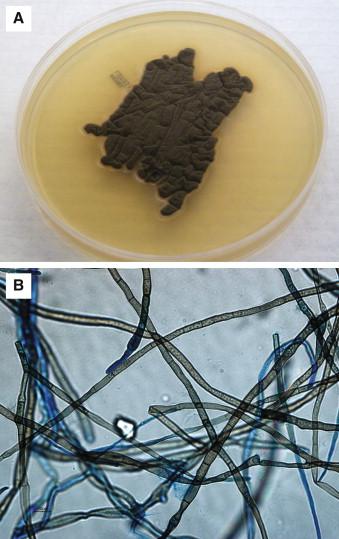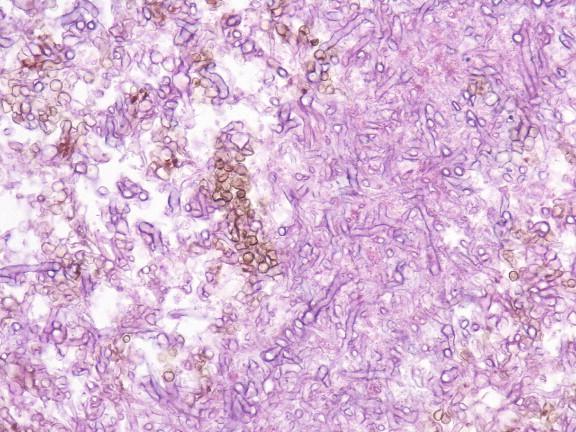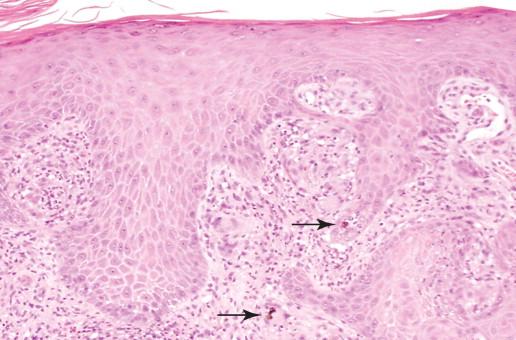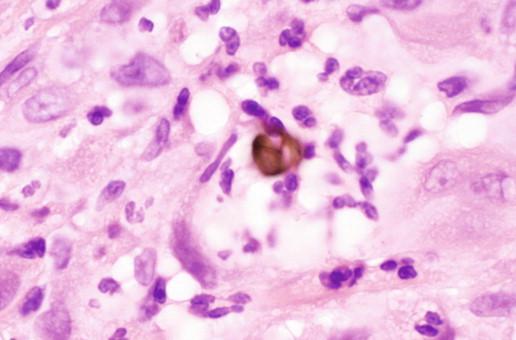Physical Address
304 North Cardinal St.
Dorchester Center, MA 02124
The term dematiaceous is used to describe fungi that are dark in coloration, typically olive colored, dark brown, or black, due to the presence of melanin or melanin-like pigment. The dematiaceous fungi are a large and diverse group and are usually saprotrophs or plant pathogens. They most often cause opportunistic infections in the immunocompromised host with a notable exception of central nervous system infections, which tend to affect immunocompetent individuals with no known risk factors. In addition, cutaneous and subcutaneous infection is typically due to direct inoculation of the fungus into the skin and subcutaneous tissue, which is independent of immune status, although immunocompromised patients may develop a more complicated clinical course.
Specimens submitted to the clinical laboratory are processed in a fashion similar to that used for other fungi, through culture and microscopic examination following staining with lactophenol blue or a similar preparation. Dematiaceous fungi will typically grow well on standard fungal media such as Sabouraud dextrose agar and will usually produce olivaceous, brown, gray, or black colonies ( Figure 25-1 A). Microscopically, they characteristically demonstrate the presence of brown to black pigment within their cell walls ( Figure 25-1 B). The pigment may not always be readily apparent on microscopic examination, however, or may be focal ( Figure 25-2 ). In these instances, special stains for melanin such as Fontana-Masson may be helpful in identifying the presence of pigmented structures. As a caveat, special stains traditionally used for fungal identification, including Gomori methenamine silver (GMS) and periodic acid-Schiff (PAS), may obscure the pigment, and therefore it is important to visualize the fungi with hematoxylin and eosin or Papanicolaou stains (or similar stains) before ruling out the presence of melanin.


In most cases, the pigmentation is due to the presence of dihydroxynaphthalene melanin. Several studies have suggested that the presence of melanin within the cell walls of dematiaceous fungi may confer a protective advantage. This advantage may be due to increased resistance to the oxidative burst of phagocytic cells or through the binding of hydrolytic enzymes and antifungal agents. The exact mechanism of melanin production has not been well established.
Infections due to dematiaceous fungi are among the most difficult to treat, often requiring prolonged administration of systemic antifungal agents in conjunction with surgery or other treatment modalities. Treatment is further complicated by the fact that these infections are infrequently encountered, and, as a result, no standard criteria for susceptibility testing of the dematiaceous fungi have been established. This often creates difficulty in the selection of appropriate agents and requires careful monitoring of the patient’s status in order to guide appropriate therapy.
Dematiaceous fungi are responsible for causing a wide range of diseases including chromoblastomycosis and the broad category of phaeohyphomycosis. Dematiaceous fungi are also important causes of eumycotic mycetoma, which will be further discussed in Chapter 14. Allergic diseases thought to be due to dematiaceous fungi include allergic fungal sinusitis and allergic bronchopulmonary mycosis. These disease entities remain somewhat controversial and their pathogenesis is not well understood at this time, therefore allergic diseases due to dematiaceous fungi will not be discussed in this chapter.
More than 150 different species of dematiaceous fungi, in 70 genera, have been identified as causative agents of disease. Each type of infection may be caused by a variety of species and some are frequently implicated in different types of infections. For these reasons, the discussion will focus more on the diseases caused by dematiaceous fungi rather than the individual species.
Chromoblastomycosis is a special type of infection with dematiaceous fungi, characterized by well-defined clinical and pathologic findings. It is a chronic infection of the skin and subcutaneous tissues caused by several groups of dematiaceous fungi, typically Fonsecaea pedrosoi, Fonsecaea compacta, Phialophora verrucosa, or Cladosporium carrionii. Chromoblastomycosis occurs worldwide but is most frequent in rural regions in tropical or subtropical climates where the incidence may be as high as 1.6 cases per 10,000 people. The disease demonstrates a striking male predominance, with an approximately 9:1 male-to-female ratio. It is assumed that men are more frequently infected due to occupational exposure (e.g., farming) in higher-prevalence areas. Children are rarely affected, presumably because of lower levels of environmental exposure and long periods of latency before the disease becomes apparent.
The organisms causing chromoblastomycosis are typically saprophytic, living in soil and on vegetation. Infection is usually caused by traumatic inoculation into the skin from a wood splinter or thorn. In some cases the injury may be relatively minor and go unnoticed by the patient.
Chromoblastomycosis most typically occurs on the lower limbs or hands but may be found anywhere on the body. Following an unknown but often lengthy period of incubation, lesions appear at the site of inoculation. The lesions are usually single, beginning as a papule that may demonstrate a hyperkeratotic appearance leading to mistaken identification as solar damage or a dermatophyte infection. The papule is often pruritic and may be painful. As the lesions progress, they will begin to spread over the skin forming erythematous scaly “warty” nodules and plaques, which may become confluent. The disease slowly evolves over several years eventually producing fungating cauliflower-like lesions if left untreated. These lesions frequently ulcerate following trauma, and adjacent satellite lesions may appear due to autoinoculation. The latter stages of the disease often lead to severe localized lymphedema, which may become disfiguring. Healed lesions frequently leave residual scarring with hypopigmentation and lymphostasis. Disseminated disease with chromoblastomycosis is rare and usually occurs via lymphatic spread.
Chromoblastomycosis is typically identified on histopathologic examination due to its characteristic appearance; however, the etiologic agents of the disease cannot be differentiated microscopically, and culture is required for definitive identification. Culture may be performed from skin scrapings or biopsy material with most organisms growing in approximately 10 days.
Chronic fungal infection of the skin and subcutaneous tissue caused by specific groups of dematiaceous fungi. Disease is characterized by pigmented muriform bodies.
Incidence may be as high as 1.6 cases per 10,000 in endemic areas.
Occurs worldwide but most frequent in rural regions in tropical or subtropical climates.
Primarily affects males in an approximately 9:1 ratio (occupational exposure).
Children are rarely affected.
Infections typically caused by traumatic inoculation into the skin from a wood splinter or thorn.
The injury may be relatively minor and go unnoticed.
Typically occurs on the lower limbs or hands but may be found anywhere on the body.
Usually single, beginning as a papule but may resemble solar damage or a dermatophyte infection.
Frequently pruritic and may be painful.
Forms erythematous scaly “warty” nodules and plaques, which may become confluent as the lesion progresses.
Eventually produces fungating “cauliflower-like” lesions if left untreated.
Lesions frequently ulcerate following trauma and adjacent satellite lesions may appear due to autoinoculation.
Disseminated disease is rare.
Rarely fatal, but can be highly disfiguring.
Can lead to serious complications such as secondary infection and squamous cell carcinoma.
Treatment course nearly always prolonged requiring multiple treatment modalities, including antifungal therapy, cryosurgery, and heat therapy.
Surgical excision with adjunct antifungal therapy for small lesions that can be completely excised.
The disease may have a wide variety of appearances depending on clinical stage. Early lesions may appear to be papules, scaly plaques, or nodules, or they may appear to be dermatophyte infections. Later lesions may be ulcerated or have a characteristic warty or cauliflower appearance. Scattered black dots are often present on the surface of lesions that are caused by transepithelial migration of fungal elements.
The lesions demonstrate a florid pseudoepitheliomatous hyperplasia of the epidermis with hyperkeratosis and parakeratosis. Chronic inflammatory cells are present in the dermis along with microabscess formation and multinucleated giant cells. Marked fibrosis is often present ( Figure 25-3 ).

The tissue morphology of the organism in cases of chromoblastomycosis is the muriform body, which is also referred to as a Medlar body, fumagoid cell, sclerotic body, or “copper penny.” These structures measure 5 to 12 μm in diameter and are dark brown with thick cell walls. Intersecting septations are frequently seen and are due to the ability of the organism to reproduce by fission instead of budding ( Figure 25-4 ). A pyogranulomatous response is commonly present. The muriform bodies are typically found within microabscesses but may be free in the tissue. The typically prominent brown pigmentation allows the sclerotic bodies to be easily visualized and special fungal stains are not usually needed. Occasionally, scattered, short segments of pigmented, septate hyphae may also be seen in cases of chromoblastomycosis.

Skin scrapings may also be taken from the lesions with an emphasis on sampling the “black spots” or other regions of dark pigmentation. Wet mounts can then be prepared using a 10% potassium hydroxide (KOH) solution allowing for a noninvasive diagnostic approach. Wet mounts will readily demonstrate classic sclerotic bodies provided the lesions are adequately sampled.
PCR assays have been developed for the detection of Fonsecaea and Cladophialophora carrionii, but are not widely available. Ribosomal gene sequencing may also be helpful in identifying difficult to characterize organisms. Polymerase chain reaction (PCR) with or without subsequent gene sequencing is most successful on organisms taken from culture.
Early lesions may appear to be papules, scaly plaques, or nodules, or they may appear to be dermatophyte infections.
Later lesions may be ulcerated or have a characteristic “warty” or “cauliflower” appearance with scattered “black dots.”
Florid pseudoepitheliomatous hyperplasia of the epidermis with hyperkeratosis and parakeratosis.
Chronic inflammatory cells are present in the dermis with microabscess formation and multinucleated giant cells.
Marked fibrosis is often present.
Muriform cells are seen within microabscesses and free within the tissue.
Special fungal stains are not typically needed to see the muriform cells due to prominent brown pigmentation.
KOH preparations of skin scrapings taken from the “black spots” of the lesions may also allow for detection of the characteristic muriform cells.
Enzyme-linked immunosorbent assays (ELISA) have been developed for F. pedrosoi and C. carrionii serologic testing. The primary utility of these assays has been for assessing the response to therapy and not for the initial diagnosis of infection. ELISA testing has primarily been utilized in research settings and is not widely available.
The differential diagnosis of chromoblastomycosis includes a variety of infectious diseases of the skin including sporotrichosis, verrucous tuberculosis, cutaneous leishmaniasis, lobomycosis, and paracoccidioidomycosis. Tissue biopsy may be particularly important in differentiating chromoblastomycosis from these entities in the event that distinguishing features are not clinically present.
Sporotrichosis, caused by the dimorphic fungus Sporothrix schenckii, is a cutaneous fungal infection that is acquired in a similar manner to chromoblastomycosis, through traumatic inoculation by a thorn or vegetable matter. Interestingly, colonies of S. schenckii are darkly pigmented when grown at 25º C, and for this reason it was previously categorized as a dematiaceous fungus. When grown at 37º C, however, it is nonpigmented and grows as a yeast. It is therefore currently considered a member of the thermally dimorphic fungi. The gross appearance is typically that of a hyperkeratotic lesion, which may have a similar appearance to early chromoblastomycosis. Although the lymphatic spread of chromoblastomycosis is rare, this is a common feature of sporotrichosis where a suppurating subcutaneous nodular lymphadenitis progresses proximally from the initial wound site. Skin biopsy characteristically reveals pseudoepitheliomatous hyperplasia of the epidermis with chronic inflammation of the dermis and microabscess formation. The microabscesses of sporotrichosis contain pink yeast forms when stained by PAS. A prominent Splendore-Hoeppli reaction is often present.
Verrucous tuberculosis occurs following exogenous inoculation of Mycobacterium tuberculosis or M. bovis into an individual who has previously been infected with tuberculosis. Skin lesions may appear similar to chromoblastomycosis and are typically painless, solitary, purulent, and warty plaques that may be accompanied by lymphadenopathy. Tissue sections characteristically demonstrate epithelial hyperplasia with underlying granulomatous inflammation and intraepidermal microabscess formation. Acid-fast bacilli are sometimes demonstrated within areas of granulomatous inflammation by Ziehl-Neelsen or Fite stains. Culture of biopsy tissue may be performed to confirm the presence of mycobacteria, and PCR may also be used, if available.
Cutaneous leishmaniasis is caused by several species of Leishmania, an intracellular protozoan parasite transmitted by the bite of the sandfly Phlebotomus (predominantly in the old world) or Lutzomyia (predominantly in the new world). Similar to chromoblastomycosis, the disease presents initially as cutaneous nodules or papules on exposed areas of skin. The nodules eventually ulcerate leaving a shallow, crater-like lesion with heaped up borders. This disease can mimic chromoblastomycosis in its insidious onset and generally slow progression. Histologic sections reveal a normal-appearing, ulcerated, or mildly hyperplastic epidermis with extensive infiltration of the dermis with chronic inflammatory cells, which may include multinucleated giant cells. The key differentiating feature is the finding of characteristic Leishmania organisms (amastigotes) within pale staining histiocytes.
Lobomycosis, caused by the fungus Lacazia loboi (formerly Loboa loboi ), may present as verrucoid or ulcerated lesions, which develop over many years. The characteristic histologic finding that differentiates this infection from chromoblastomycosis is chains of uniform-appearing round to lemon-shaped yeasts connected by intracellular bridges. The yeasts may additionally demonstrate a “Maltese cross” appearance under polarized light, a feature lacking in the muriform bodies of chromoblastomycosis.
Paracoccidioidomycosis, caused by the dimorphic fungus Paracoccidioides brasiliensis, may demonstrate cutaneous dissemination or may show skin manifestations following direct inoculation. The disease is characterized by slow-growing, painful, ulcerated or verrucous nodules. The distinctive circumferential budding or “mariner’s wheel” appearance of the yeast is helpful in distinguishing this infection from chromoblastomycosis.
Squamous cell carcinoma is an important noninfectious consideration, not only because the appearance can be similar to chromoblastomycosis, particularly in its early stages, but also because squamous cell carcinoma may arise from the lesions of chromoblastomycosis. Fortunately, squamous cell carcinomas arising from chromoblastomycotic lesions tend to be slowly progressive without deep invasion and rarely result in death.
Chromoblastomycosis is rarely fatal but can be highly disfiguring and lead to serious complications such as secondary infection and squamous cell carcinoma. The disease only rarely spontaneously remits and may demonstrate a lifelong course.
Chromoblastomycosis is among the most difficult deep fungal infections to eradicate, and standard guidelines for treatment have not been firmly established. The treatment course is nearly always prolonged and requires multiple treatment modalities, especially in advanced cases. In severe cases, attempts to completely eradicate the disease are often unsuccessful, and management of the fungal burden becomes the goal of therapy. Antifungal regimens typically include itraconazole either as monotherapy or with 5-flucytosine. Locally applied heat therapy has been successful in some studies, presumably because increased temperatures have negative effects on fungal growth. Surgical excision is usually only indicated if the lesions are small and can be completely excised. Surgery additionally carries a high risk of dissemination, and adjunctive antifungal therapy is recommended. Cryosurgery alone or combined with itraconazole for 6 to 8 months has been advocated by some practitioners depending on the extent of the lesions. Amputation is rarely indicated as the disease usually does not invade into deep tissues, but it may be a consequence of secondary infection or malignant transformation. The extent of the lesions and severity of secondary complications may dictate the optimal treatment modalities and combinations, particularly as these infections are often first seen at advanced stages.
Phaeohyphomycosis is an extremely broad category of mycotic infections caused by dematiaceous fungi in which the tissue morphology is predominantly mycelial (i.e., composed of hyphae). This differs from chromoblastomycosis, which is characterized by muriform bodies. The name phaeohyphomycosis is derived from the Greek word “Phaeo” meaning dusky or dark. The agents of phaeohyphomycosis may have a dark coloration in culture, but it is also important to remember that the gross appearance of these lesions may be at least partially pigmented as well. For purposes of this text, the phaeohyphomycoses will be divided into the corneal, sinus, subcutaneous, pulmonary, central nervous system, and disseminated phaeohyphomycosis. The most common agents involved in these infections are listed under their specific sections.
Fungal organisms are an important cause of keratitis worldwide but are particularly prevalent in tropical climates. Approximately 40% of all infectious keratitis is caused by fungi, most commonly Fusarium and Aspergillus , however, dematiaceous fungi account for a substantial 20% of these cases. The most common dematiaceous fungi involved in fungal keratitis are Curvularia and Bipolaris with Exserohilum and Lasiodiplodia being less commonly implicated agents. Trauma is the most important risk factor for fungal infections of the eye, being involved in approximately half of the cases. Traumatic inoculation usually involves plant material, although other foreign bodies such as metal fragments have also been implicated. Additional risk factors include diabetes mellitus, contact lenses use, and prior eye surgery. Patients typically present with photophobia, eye redness, lacrimation, and visual disturbances.
KOH-prepped smears taken from corneal scrapings may be of initial diagnostic utility. Alternatively, Gram or Giemsa stains may be used if the etiology of the infection is unclear, as these stains are better at demonstrating the presence of bacteria or the cytopathic effect of viral infections but will demonstrate hyphae as well. Special fluorescent stains for the detection of fungi, such as calcofluor white, may also be helpful provided a fluorescent microscope is available. As with other diseases caused by dematiaceous fungi, definitive diagnosis of the causative organism relies on culture.
Rhinosinusitis is caused by more than 50 different fungal species, including hyaline molds such as Aspergillus and Fusarium species and dematiaceous molds such as Curvularia, Bipolaris, Alternaria, Pseudallescheria, and Exserohilum species. Infection is typified by noninvasive, recurrent infection with significant associated morbidity. Less commonly, invasion into the surrounding soft tissue, bone, and even the central nervous system is seen. Invasion is a rare phenomenon, seen primarily in immunocompromised hosts, including those with uncontrolled diabetes and severe malnutrition.
Patients with noninvasive infection are usually immunocompetent and have symptoms of chronic or recurrent sinusitis. Many have a history of general atopy. The presence of nasal polyps and failure to respond to agents for bacterial sinusitis are common. Invasive disease presents with headache, fever, cough, epistaxis, nasal mucosal ulceration, and, in advanced disease, proptosis. Diagnosis is usually by sinus endoscopy with biopsy or surgical debridement of necrotic tissue. Culture should be performed for definitive diagnosis of the causative agent.
Become a Clinical Tree membership for Full access and enjoy Unlimited articles
If you are a member. Log in here